2015 FIAT GRANDE PUNTO ACTUAL washer fluid
[x] Cancel search: washer fluidPage 171 of 216

170
SAFETY
STARTING
AND DRIVING
WARNING
LIGHTS AND
MESSAGES
IN AN
EMERGENCY
TECHNICAL
SPECIFICATIONS
INDEX
CONTROLS
AND DEVICES
SERVICE
AND CARE
If the vehicle is used mainly around town or the annual distance travelled is less than 10,000 km, the engine oil
and oil filter must be changed every 12 months.
Thousands of kilometres
Check exhaust gas emissions
Check battery charge status and possibly recharg
Replace air filter cartridge
Top up fluid levels (engine coolant, brakes,
battery, windscreen washer, etc.)
Check condition of timing belt
Check engine management system operation
(through diagnostic socket)
Replace spark plugs
Replace toothed timing belt (*)
Change engine oil and replace oil filter (or every 24 months)
Change brake fluid (or every 24 months)
Replace pollen filter (or every 24 months)
(*) Regardless of the distance covered, the timing belt should be replaced every 4 years for particularly demanding use (cold climates, city driving, idling for a long
time, dusty areas) or in any case every 5 years.
30 60 90 120 150 180
●●●●● ●
●●●●● ●
●● ●
●●●●● ●
●●
●●●●● ●
●●●●● ●
●
●●●●● ●
●● ●
●●●●● ●
167-186 ACTUAL 1ed EN 18-01-2011 16:31 Pagina 170
Page 172 of 216
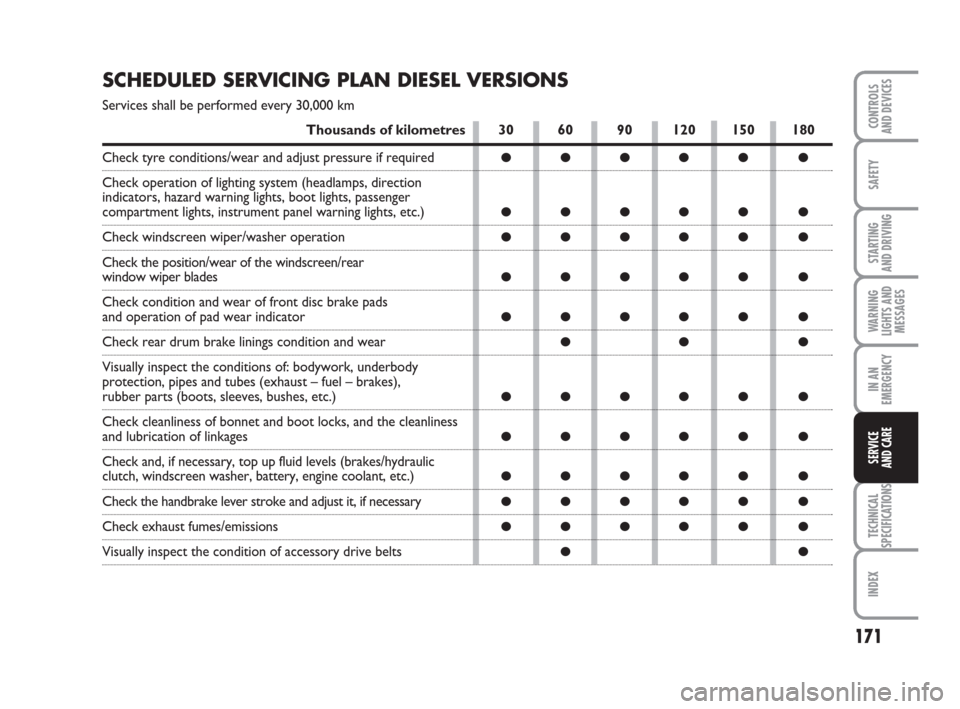
171
SAFETY
STARTING
AND DRIVING
WARNING
LIGHTS AND
MESSAGES
IN AN
EMERGENCY
TECHNICAL
SPECIFICATIONS
INDEX
CONTROLS
AND DEVICES
SERVICE
AND CARE
SCHEDULED SERVICING PLAN DIESEL VERSIONS
Services shall be performed every 30,000 km
30 60 90 120 150 180
●●●●● ●
●●●●● ●
●●●●● ●
●●●●● ●
●●●●● ●
●● ●
●●●●● ●
●●●●● ●
●●●●● ●
●●●●● ●
●●●●● ●
●●
Thousands of kilometres
Check tyre conditions/wear and adjust pressure if required
Check operation of lighting system (headlamps, direction
indicators, hazard warning lights, boot lights, passenger
compartment lights, instrument panel warning lights, etc.)
Check windscreen wiper/washer operation
Check the position/wear of the windscreen/rear
window wiper blades
Check condition and wear of front disc brake pads
and operation of pad wear indicator
Check rear drum brake linings condition and wear
Visually inspect the conditions of: bodywork, underbody
protection, pipes and tubes (exhaust – fuel – brakes),
rubber parts (boots, sleeves, bushes, etc.)
Check cleanliness of bonnet and boot locks, and the cleanliness
and lubrication of linkages
Check and, if necessary, top up fluid levels (brakes/hydraulic
clutch, windscreen washer, battery, engine coolant, etc.)
Check the handbrake lever stroke and adjust it, if necessary
Check exhaust fumes/emissions
Visually inspect the condition of accessory drive belts
167-186 ACTUAL 1ed EN 27-07-2010 10:30 Pagina 171
Page 174 of 216

173
SAFETY
STARTING
AND DRIVING
WARNING
LIGHTS AND
MESSAGES
IN AN
EMERGENCY
TECHNICAL
SPECIFICATIONS
INDEX
CONTROLS
AND DEVICES
SERVICE
AND CARE
DEMANDING USE
OF THE CAR
Should the car be used predominantly in
one of the following particularly demand-
ing conditions:
❒trailer or caravan towing;
❒dusty roads;
❒short (less than 7-8 km) and repeated
journeys in sub-zero temperatures;
❒ frequently idling engine or long-dis-
tance, low-speed driving (e.g. door-to-
door deliveries) or lengthy inactivity;
❒ driving in towns and cities;
you should perform the following inspec-
tions more frequently than shown on the
Scheduled Servicing Plan:
❒ check front disc brake pad conditions
and wear;
❒check cleanliness of bonnet and boot
locks, and cleanliness and lubrication of
linkages;
❒ visually inspect the conditions of: en-
gine, gearbox, transmission, pipes and
tubes (exhaust – fuel – brakes), rubber
parts (boots, sleeves, bushes, etc.);
❒check battery charge and liquid level
(electrolyte);
❒visually inspect the condition of the ac-
cessory drive belts;
❒check pollen filter and replace, if re-
quired;
❒check air filter and replace, if required.
REGULAR CHECKS
Every 1,000 km or before long journeys,
check and, if necessary, top up:
❒engine coolant fluid level;
❒brake fluid level;
❒windscreen washer level;
❒tyre pressure and conditions.
❒operation of lights (headlights, direction
indicators, hazard lights, etc.);
❒operation of the windscreen wiper/
washer system, position and wear of
the windscreen and rear window wiper
blades;
Every 3,000 km, check and top up, if re-
quired, the engine oil level.
You are recommended to use PETRONAS
LUBRICANTS products, which have been
designed and produced specifically for
Fiat cars (see table “Capacities” in the
“Technical specifications” section).
167-186 ACTUAL 1ed EN 27-07-2010 10:30 Pagina 173
Page 175 of 216
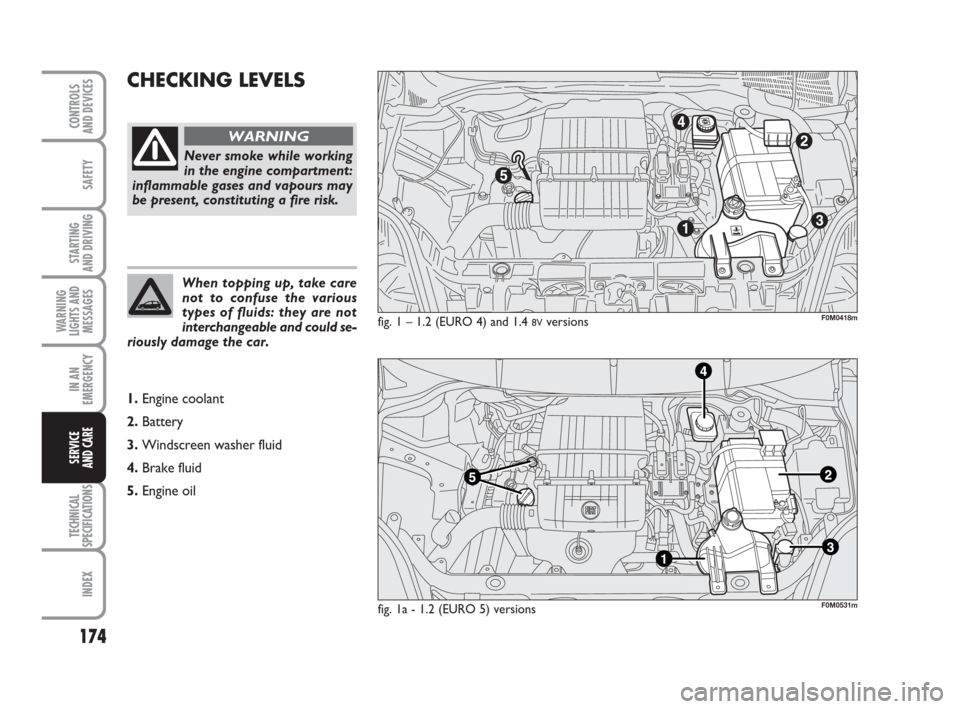
174
SAFETY
STARTING
AND DRIVING
WARNING
LIGHTS AND
MESSAGES
IN AN
EMERGENCY
TECHNICAL
SPECIFICATIONS
INDEX
CONTROLS
AND DEVICES
SERVICE
AND CARE
CHECKING LEVELS
fig. 1 – 1.2 (EURO 4) and 1.4 8Vversions
Never smoke while working
in the engine compartment:
inflammable gases and vapours may
be present, constituting a fire risk.
WARNING
When topping up, take care
not to confuse the various
types of fluids: they are not
interchangeable and could se-
riously damage the car.
1. Engine coolant
2. Battery
3. Windscreen washer fluid
4. Brake fluid
5. Engine oil
F0M0418m
fig. 1a - 1.2 (EURO 5) versionsF0M0531m
167-186 ACTUAL 1ed EN 27-07-2010 10:30 Pagina 174
Page 176 of 216
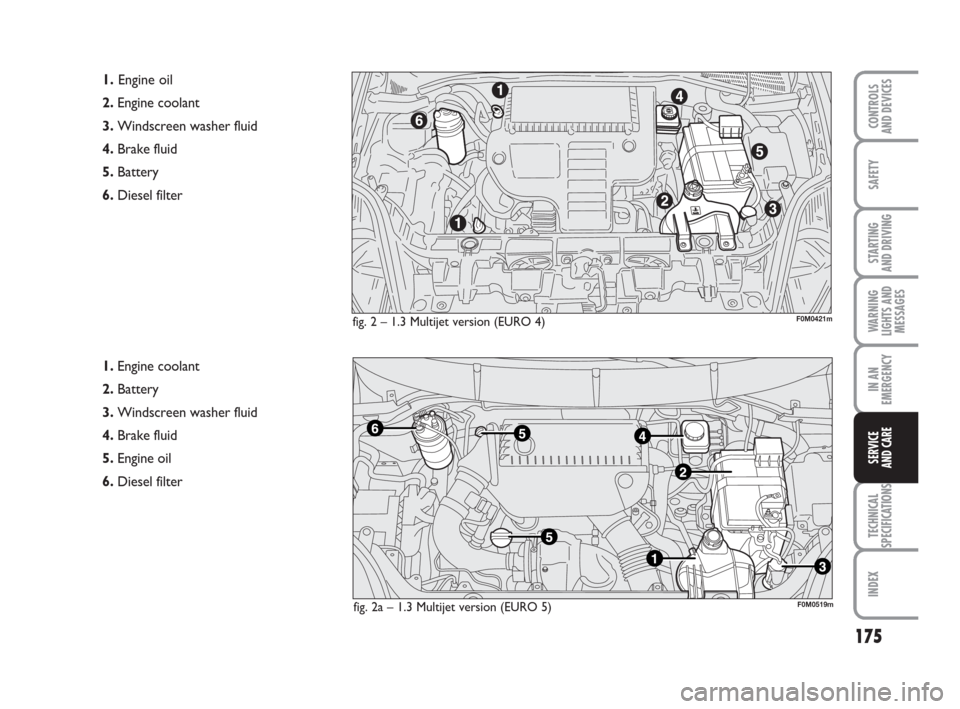
175
SAFETY
STARTING
AND DRIVING
WARNING
LIGHTS AND
MESSAGES
IN AN
EMERGENCY
TECHNICAL
SPECIFICATIONS
INDEX
CONTROLS
AND DEVICES
SERVICE
AND CARE
fig. 2 – 1.3 Multijet version (EURO 4)
1.Engine oil
2. Engine coolant
3. Windscreen washer fluid
4. Brake fluid
5. Battery
6. Diesel filter
1. Engine coolant
2. Battery
3. Windscreen washer fluid
4. Brake fluid
5. Engine oil
6. Diesel filter
F0M0421m
fig. 2a – 1.3 Multijet version (EURO 5)F0M0519m
167-186 ACTUAL 1ed EN 27-07-2010 10:30 Pagina 175
Page 179 of 216
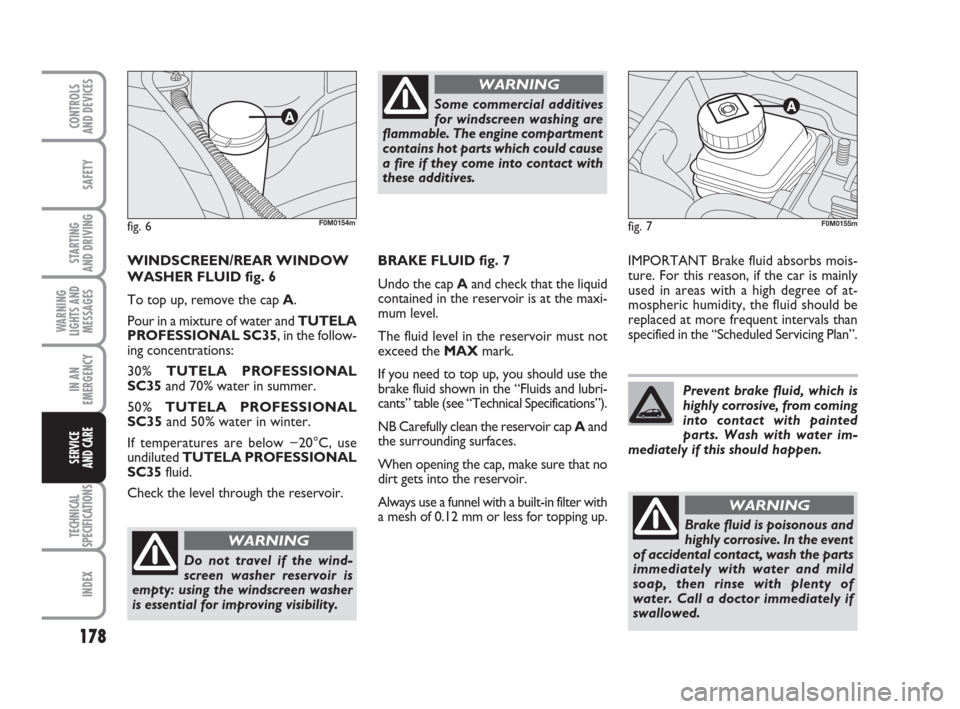
178
SAFETY
STARTING
AND DRIVING
WARNING
LIGHTS AND
MESSAGES
IN AN
EMERGENCY
TECHNICAL
SPECIFICATIONS
INDEX
CONTROLS
AND DEVICES
SERVICE
AND CARE
IMPORTANT Brake fluid absorbs mois-
ture. For this reason, if the car is mainly
used in areas with a high degree of at-
mospheric humidity, the fluid should be
replaced at more frequent intervals than
specified in the “Scheduled Servicing Plan”.
fig. 7
Do not travel if the wind-
screen washer reservoir is
empty: using the windscreen washer
is essential for improving visibility.
WARNING
Some commercial additives
for windscreen washing are
flammable. The engine compartment
contains hot parts which could cause
a fire if they come into contact with
these additives.
WARNING
Prevent brake fluid, which is
highly corrosive, from coming
into contact with painted
parts. Wash with water im-
mediately if this should happen.
WINDSCREEN/REAR WINDOW
WASHER FLUID fig. 6
To top up, remove the cap A.
Pour in a mixture of water and TUTELA
PROFESSIONAL SC35, in the follow-
ing concentrations:
30% TUTELA PROFESSIONAL
SC35and 70% water in summer.
50% TUTELA PROFESSIONAL
SC35and 50% water in winter.
If temperatures are below −20°C, use
undiluted TUTELA PROFESSIONAL
SC35fluid.
Check the level through the reservoir.
fig. 6F0M0154m
BRAKE FLUID fig. 7
Undo the cap Aand check that the liquid
contained in the reservoir is at the maxi-
mum level.
The fluid level in the reservoir must not
exceed the MAXmark.
If you need to top up, you should use the
brake fluid shown in the “Fluids and lubri-
cants” table (see “Technical Specifications”).
NB Carefully clean the reservoir cap Aand
the surrounding surfaces.
When opening the cap, make sure that no
dirt gets into the reservoir.
Always use a funnel with a built-in filter with
a mesh of 0.12 mm or less for topping up.
F0M0155m
Brake fluid is poisonous and
highly corrosive. In the event
of accidental contact, wash the parts
immediately with water and mild
soap, then rinse with plenty of
water. Call a doctor immediately if
swallowed.
WARNING
167-186 ACTUAL 1ed EN 27-07-2010 10:30 Pagina 178
Page 184 of 216

183
SAFETY
STARTING
AND DRIVING
WARNING
LIGHTS AND
MESSAGES
IN AN
EMERGENCY
TECHNICAL
SPECIFICATIONS
INDEX
CONTROLS
AND DEVICES
SERVICE
AND CARE
Replacing the windscreen
wiper blades fig. 9
How to remove the blade:
❒raise the windscreen wiper arm A;
❒rotate blade B90° around pin C, lo-
cated at the end of the wiper arm;
❒remove the blade from the pin C.
How to insert the blade:
❒fit pin Cinto the hole located in the
middle of the blade B;
❒lower the arm so the blade rests back
on the windscreen.
fig. 9F0M0161m
Changing the rear
window wiper blade fig. 10
Proceed as follows:
❒raise the cover Aand remove the arm
from the car by slackening the nut B
that fastens it to the pivot pin;
❒fit the new arm, positioning it correct-
ly, and fully tighten the nut;
❒lower the cover.
fig. 10F0M0162m
SPRAY NOZZLES
Windscreen washer fig. 11
If the jet is not coming out, firstly check
that there is fluid in the reservoir (see
“Checking levels” in this section).
Then check that the nozzle holes are not
clogged; use a needle to unblock them if
necessary.
fig. 11F0M0163m
167-186 ACTUAL 1ed EN 27-07-2010 10:30 Pagina 183
Page 202 of 216
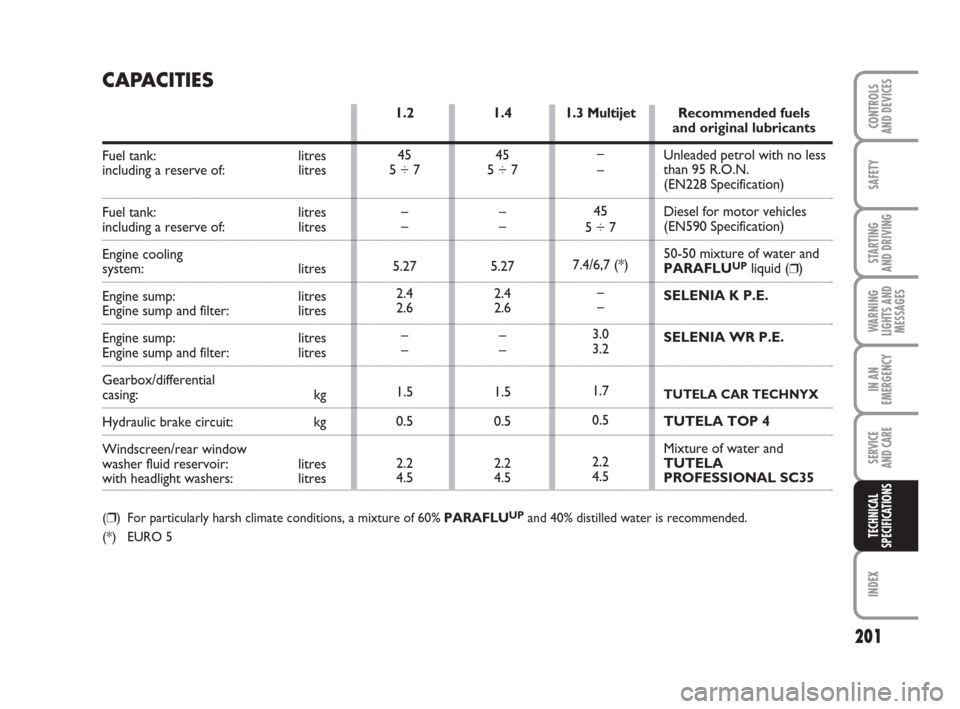
201
SAFETY
STARTING
AND DRIVING
WARNING
LIGHTS AND
MESSAGES
IN AN
EMERGENCY
SERVICE
AND CARE
INDEX
CONTROLS
AND DEVICES
TECHNICAL
SPECIFICATIONS
1.3 Multijet
–
–
45
5 ÷ 7
7.4/6,7 (*)
–
–
3.0
3.2
1.7
0.5
2.2
4.5 1.4
45
5 ÷ 7
–
–
5.27
2.4
2.6
–
–
1.5
0.5
2.2
4.5 1.2
45
5 ÷ 7
–
–
5.27
2.4
2.6
–
–
1.5
0.5
2.2
4.5
CAPACITIES
Fuel tank: litres
including a reserve of: litres
Fuel tank: litresincluding a reserve of: litres
Engine cooling
system: litres
Engine sump: litres
Engine sump and filter: litres
Engine sump: litres
Engine sump and filter: litres
Gearbox/differential
casing: kg
Hydraulic brake circuit: kg
Windscreen/rear window
washer fluid reservoir: litres
with headlight washers: litres
(❒) For particularly harsh climate conditions, a mixture of 60% PARAFLUUPand 40% distilled water is recommended.
(*) EURO 5
Recommended fuels
and original lubricants
Unleaded petrol with no less
than 95 R.O.N.
(EN228 Specification)
Diesel for motor vehicles
(EN590 Specification)
50-50 mixture of water and
PARAFLU
UPliquid (❒)
SELENIA K P.E.
SELENIA WR P.E.
TUTELA CAR TECHNYX
TUTELA TOP 4
Mixture of water and
TUTELA
PROFESSIONAL SC35
187-204 ACTUAL 1ed EN 26-07-2010 16:08 Pagina 201